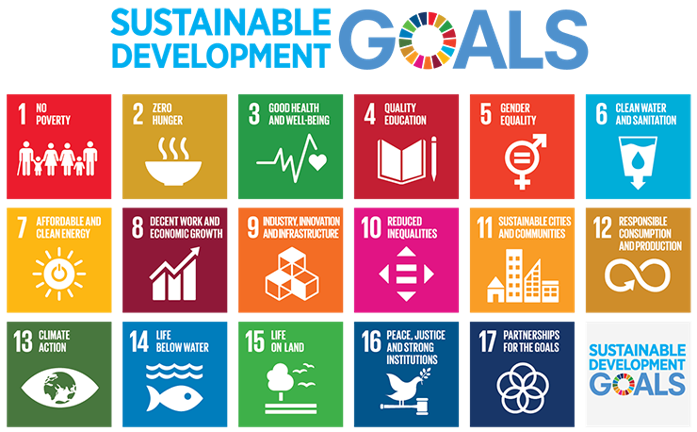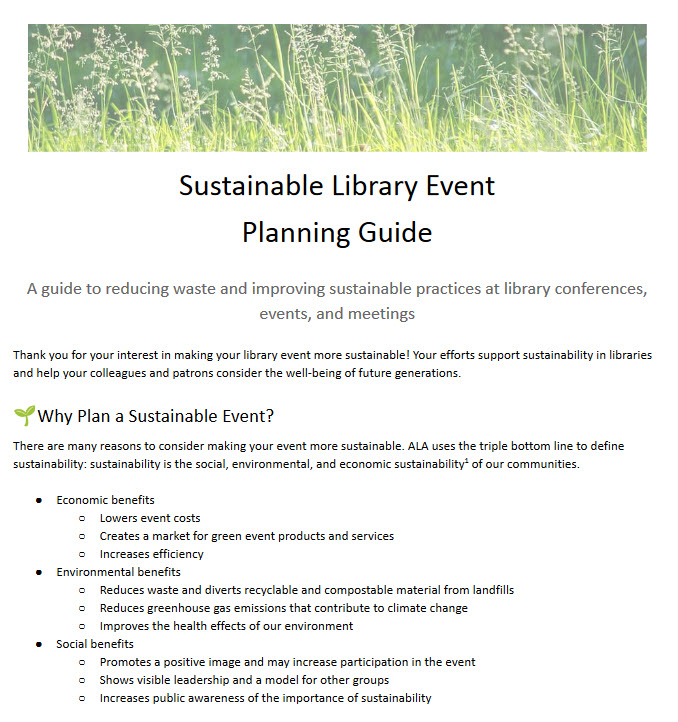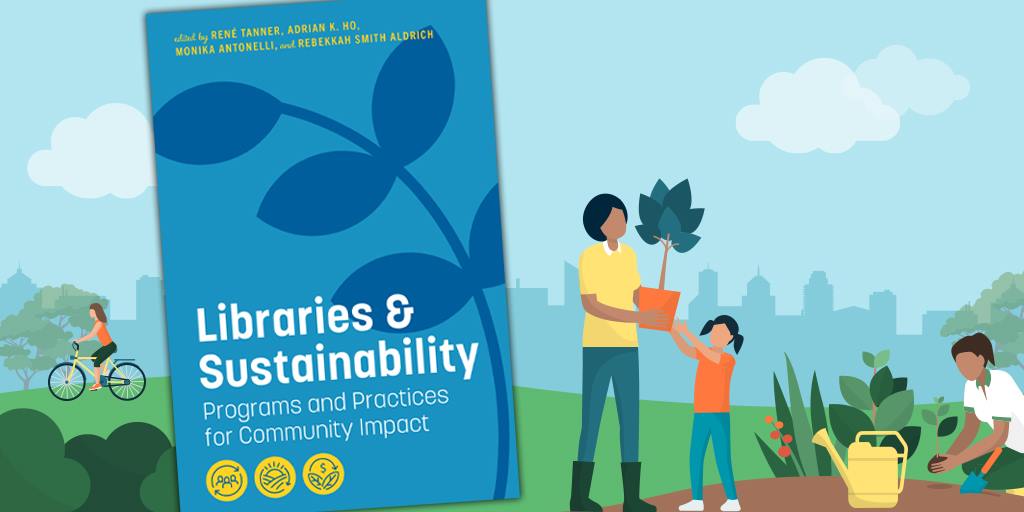Programs that Walk the Talk
This article is part of the series of resources and webinars created by the Sustainable Libraries Initiative team, in collaboration with WebJunction, to support libraries in creating a more sustainable future.
Throughout this Climate Action series, we have discussed strategies and practical steps libraries can take toward sustainability, as well as resources to support these efforts. The Sustainable Libraries Initiative can help support a balanced approach to facilities management, policymaking, collections, partnerships, and library services and programs.
Thanks to observations of more than 100 libraries working on the Sustainable Library Certification Program, the Sustainable Libraries Initiative has identified four key characteristics of a “Sustainable Library”:
- Strong and authentic institutions that live their values out loud
- Catalysts for social cohesion and civic participation in communities
- Deliberate action on climate mitigation (the reduction of greenhouse gas emissions)
- Active participants in climate adaptation (strengthening community resilience)
As libraries strive to manifest these characteristics through the programming offered by the library, there are three phases of work to consider through this lens: Design, Implementation, and Evaluation.
Design
Programs should align with a library’s mission, vision, core values, and strategic goals. Therefore, a commitment to sustainability needs to be evident in these statements and documents. A top-level acknowledgement of the need for every library in the land to adopt sustainability as a core value, just as the American Library Association has done, is critical to ensuring an authenticity to this work.
With strategic goals in alignment with the above stated characteristics of a Sustainable Library, program ideas will easily flow onto the calendar of events as desired outcomes are clearer. If we know part of our vision is to be a catalyst for social cohesion and civic participation, then a survey of the literature and program idea banks, such as the one at the Sustainable Libraries Initiative and the site ProgrammingLibrarian.org, yields plenty of ideas to get us started. If we know part of our strategic goals are to both model and inspire folks in our community to reduce greenhouse gas emissions, select programs that focus on options for renewable energy, electric vehicles, and reducing the amount of stuff in the waste stream. If we are clear that we have a mandate to partner with others in our community to strengthen community resilience in the face of climate change, then programs that focus on preparedness, self-sufficiency, and social cohesion (again!) become natural fits.
The final session in the webinar series addresses the topic of libraries as catalysts for social cohesion and civic participation with plenty of ideas for programs that help a library fulfill this role.
Implement
How we carry out programs at the library matters. Non-verbal cues can be as impactful as lofty vision statements about intentions. Walking the talk requires forethought as to how we spend our money and time in the context of our stated values.
In the book Libraries & Sustainability: Programs and Practices for Community Impact (ALA Editions, 2021) there is a chapter devoted to sustainable event planning. Chapter authors Mandi Goodsett and Evan Meszaros lay out key choices to be made around promoting programs, including travel to programs, food choices, and minimizing waste at events.
Here are some key phrases to be familiar with as you consider how to plan events that “walk the talk” of sustainability:
- Zero Waste: A zero-waste event is designed to reduce, or even eliminate, the production of waste and limit the use of raw materials. This can be done through the use of reusable, recyclable, and compostable items. To learn more, check out the Sustainable Event Planning Guide for Libraries and Sustainable Swag Self-Evaluation for Library Workers created by members of ALA's Sustain Round Table.
- Upcycling: Upcycling refers to creating something new from discarded materials by repairing, refurbishing, or repurposing them. This is a key phrase for library staff who plan craft programs for all ages. By reusing items for craft and art projects we reduce the demand for raw materials and divert materials from the waste stream.
- Carbon-neutral: Climate change is driven by the emission of greenhouse gasses; carbon removal seeks to lock these gasses away. The term “carbon-neutral” means having a balance between emitting carbon—through fossil-fueled heating and cooling of facilities, fossil-fuel vehicles, and solid waste in landfills—and absorbing carbon from the atmosphere in carbon sinks. A carbon sink is anything that absorbs more carbon from the atmosphere than it releases – for example, plants, the ocean and soil. In 2021, the Council of the American Library Association approved CD53 Resolution to Achieve Carbon Neutrality for ALA Conferences. The ALA Council Committee on Sustainability was charged with assisting and tracking progress toward this goal. To this end they created this handy Carbon Neutral / Carbon Offset FAQ to provide a very brief primer for those new to the conversation around carbon neutrality and carbon offsets.
Evaluate

IFLA SDGs Presentation, CC BY 4.0 DEED
While we all have good intentions with the programs we have planned, what is the actual impact of our efforts? We have a responsibility to evaluate our efforts to measure if we are having the desired outcomes. The Institute of Museum and Library Services (IMLS) defines outcomes as benefits to people: specifically, “achievements or changes in skill, knowledge, attitude, behavior, condition, or life status for program participants” ("visitors will know what architecture contributes to their environments," "participant literacy will improve").[1] Outcome-based evaluation (OBE) has long been an accepted practice in our profession and tools like the Public Library Association’s Project Outcome (designed for both public and academic libraries) make it even easier for us to measure not only the impact of our programs with templated surveys, but to also align our efforts with the United Nation’s Sustainable Development Goals. You can learn more about this new Project Outcome feature here.
Programs are a major growth area for libraries, helping to skyrocket library usage over the past twenty-five years. As libraries are part of the education infrastructure of our communities, we have a responsibility to purposefully design events that not only live our values out loud but enhance the quality of life for our constituents.
References
[1] https://www.imls.gov/grants/outcome-based-evaluation/basics
Webinars in the series
Visit each listing for recordings and handouts and use the Series Learner Guide (doc) together or with others, to take action on your learning.
Sustainability 101
Recording now available
Climate Action Planning (Part 1): An Introduction
Recording now available
Climate Action Planning (Part 2): Disaster Preparedness and Community Resilience
Recording now available
Climate Justice
Recording now available
Living Our Values Out Loud: Programs that Walk the Talk
Recording now available
Stronger Together: Collective Impact and Climate Action Programming
Recording now available
Inspired to learn more?
If you’re looking for climate justice strategies you can subscribe to the free, monthly newsletter of the Sustainable Libraries Initiative for more ideas, stories from the field, and resources to help your library and community.


